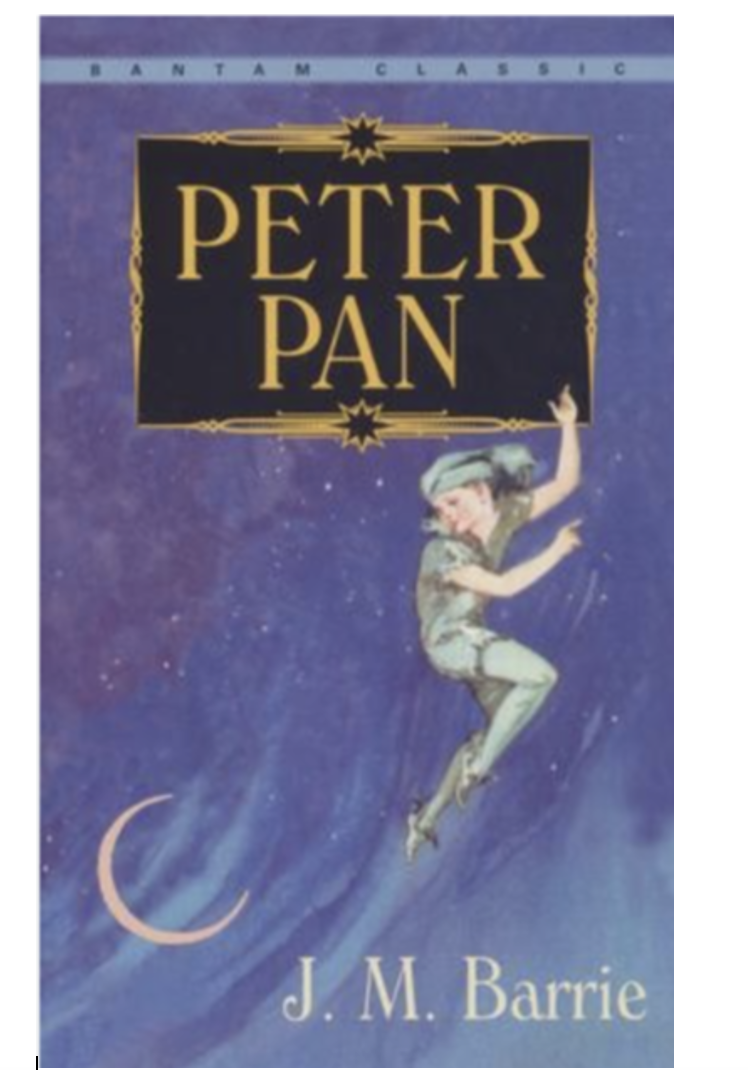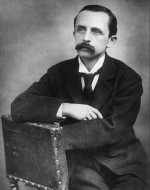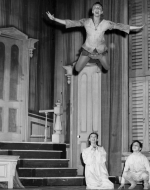Created by Julia Maguire on Sun, 10/13/2024 - 12:11
Description:
Peter Pan (1904) by J.M. Barrie is an imaginative and adventurous story that has remained a staple in the children’s canon. Protagonist Peter Pan is a boy who cannot grow up. Peter visits the home of the Darling family and takes siblings John, Michael, and Wendy from their nursery in London, England to the magical world of Neverland. In Neverland, Peter and the Darling children face swashbuckling pirates, whimsical fairies, mischievous lost boys, and mystical mermaids. While their adventures are exciting, the Darling children are met with the choice to sacrifice their ability to grow up by staying with Peter Pan in Neverland or fly back to London and return to their normal lives.
Peter Pan (1904) has been an iconic figure of children's entertainment for 120 years. Originally taking form as a playwright, the story of Peter and the Darling children has since flown from the stage, to literature, to film. The story is grounded in themes such as preserving childhood and reluctance to grow up. These ideas are relatable to all readers from the time of the book’s original publishing to now, which have maintained the story’s success and popularity. However, in the 21st century the story of Peter Pan is best known as the Walt Disney 1953 film rather than the original book by J.M. Barrie. Many people today only know Peter as the animated character voiced by Bobby Driscoll without understanding the rich background preceding Disney’s rendition. By exploring the history and meaning behind this timeless narrative, Peter Pan may regain its footing as a book of place in London, England as well as reclaim Barrie’s original intentions for the story.
Book Cover, Peter Pan (1904), by J.M. Barrie, 1985 edition. The story of Peter Pan (1904) begins in the nursery in the home of the Darling Family, where the oldest child, Wendy, tells her two younger brothers, John and Michael, bedtime stories. When Mr. and Mrs. Darling leave for a dinner party, Peter Pan and Tinkerbell fly in through the window, and Peter confesses how much he and the Lost Boys enjoy Wendy's stories. Peter asks Wendy to fly back to Neverland with him, a whimsical place where children never grow up. If she were to follow Tink and Peter, Wendy would embark on many fun adventures and mother the Lost Boys and her brothers. Wendy is hesitant but ultimately agrees, and Peter flies the Darling children out of London and into Neverland. When they arrive in Neverland, Wendy, John, and Michael have a lot of fun going on adventures and leading their new lives, but they are frightened of the pirates who also live on the island. Peter and Wendy begin to quarrel, which sparks Peter Pan's overarching theme about the fears of growing up and losing a child-like lust and innocence. Peter chose to fly away to Neverland to maintain his youth forever, and now Wendy is faced with the same opportunity. She debates whether to stay in Neverland, and lead an adventurous life of fun with Peter and the Lost Boys in their eternal adolescence, or return to London with her family, and grow up like any average girl.
"Barrie," photograph by The Granger Collection, 1893, Britannica Encyclopedia. J.M. Barrie (1860-1937) was a best selling British novelist and dramatist of the late 19th and early 20th century. He began his career working on the Nottingham Journal, before moving to London to become a freelance writer. Barrie started out writing mostly novels, but then moved to writing for theater later in his career. His first best selling works included A Window in Thurms written in 1889, and The Little Minister (1891). His most acclaimed work however, was Peter Pan. Inspiration for this book came when Barrie was merely six years old. His household was struck with tragedy when his older brother tragically passed away in an ice skating accident days before turning fourteen years old. It is said that no one in the Barrie family was able to recover from the devastating loss. The story Barrie crafted of Peter and the Darling children seeked to paint a picture of the happy times of his childhood prior to his brother's death. It is through this celebrated narrative that J.M. Barrie was able to preserve the child-innocence that was taken from him too soon, and foster that magic in all of his readers.
"Peter Pan played by Mary Martin," photograph, 1954, Wikipedia. Prior to Peter Pan as a novel or animated film, its original form was as a playwright by J.M. Barrie in 1904. Peter as a character was first introduced two years prior, as the protagonist in J.M. Barrie’s novel The Little White Bird. The story follows a conversation between a middle aged man and a young boy who meet in the Kensington Gardens of London, England. The man tells stories of Peter Pan’s adventures to the young boy, all while emphasizing themes such as childhood and the fear of growing up that readers see so clearly in Peter Pan as well. Following the success of The Little White Bird and the popularity of Peter's character, J.M. Barrie wrote the playwright for Peter Pan. The show debuted in The Duke of York's Theatre in London in December of 1904, and on Broadway in New York City the following year. Due to the show’s success in both England and America, J.M. Barrie decided to write a revised version of the play to include five acts, which was produced in 1928. Later on in 1954, Peter Pan, an original Broadway production, debuted in New York City. With music by Moose Charlap and Jule Styne, the production was a huge success, being revived several times over the last 70 years. Just this past year, Peter Pan The Musical went out on national tour with director Lonny Price, bringing the magic of Neverland all across the United States. While the success of Peter Pan on Broadway has been tremendous, the portrayal of characters in film, musical, and play adaptations may alter the depth of Barrie's creative vision. It is important to continue honoring the story's roots through J.M. Barrie's writting.
Collage of Peter Pan Walt Disney, 1953, The Disney Wiki; Peter Pan Illustration by F.D. Bedford; Mabel Lucie Attwell, 1921 (reprinted in a 1995 edition courtesy of Dr. Catherine Golden); F.D. Bedford Illustration, 1911, Wikipedia. Now with it being over a century since Peter Pan was first published, there have been many new editions of Peter Pan that have turned this story into a world famous franchise. From the many book adaptations, to the musical and play productions, to the celebrated 1953 animated Disney film, it is particularly interesting to note the different ways illustrators and animators have chosen to portray Peter as a character. According to J.M. Barrie’s novel Peter is twelve years old, however, in many illustrations of Peter, readers and viewers may find this difficult to believe. The image on the bottom left by Mabel Lucie Attwell presents Peter with a very baby-like, innocent complexion, making him seem no older than seven or eight. However, this image is starkly contrasted in Walt Disney’s version of Peter which is shown directly above. Here Peter appears to be much older, with a taller more manly build causing him to seem about sixteen or seventeen years old. In many of the play and musical adaptations of Peter Pan, Peter is played by a man rather than a young boy. This discrepancy across the portrayals of Peter contributes poorly to the overarching theme of his inability to grow up. It takes away from J.M. Barrie’s motive for writing this beloved story and distracts readers and viewers from the meaning behind the narrative.
"Statue in Kensington Gardens," photograph by Peter Clarke, 2009., Wikipedia. In the midst of Kensington Gardens located in London, England stands a fourteen foot tall bronze sculpture titled “The Shrine of Youth: The Peter Pan Statue.” This intricately detailed statue shows a tree stump, decorated with various whimsical creatures and animals including rabbits, mice, squirrels and fairies. At the top stands Peter Pan, blowing a musical instrument, seemingly a flute or pan pipes. Made by British sculptor Sir George Frampton, this piece has been a part of Kensington Gardens since 1912. Interestingly, the piece was commissioned by author J.M. Barrie himself. The location of the statue is intentional as many of Barrie’s stories gained inspiration from Kensington Gardens such as his novel The Little White Bird (1902). The statue is also located very closely to Barrie’s childhood home, paying tribute to his brother who inspired so much of Peter’s character. This sculpture is a beautiful metaphor for the intention behind Peter Pan. Although the story remains a household name even after 120 years, many people only know Peter’s character from Walt Disney’s 1953 animated film and are unaware of its roots as a novel and playwright. Peter’s everlasting presence in London shows it is a story of place, and Barrie’s commission of this piece takes back the narrative. Although there have been several adaptations and new portrayals of Peter throughout the years, he is forever rooted in the Kensington Gardens as a reminder of what Peter symbolizes for Barrie, a timeless sense of youth and adventure.






